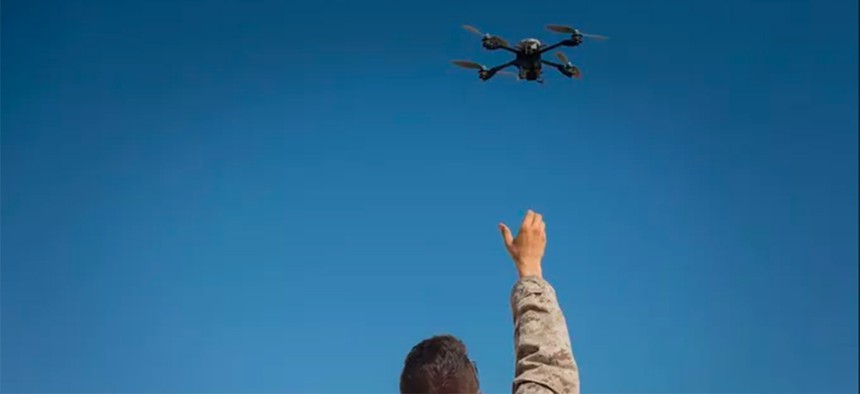The Marines Are Giving Quadcopters to Every Squad

U.S. Marine Corps
The Corps says new robots, tech, and video games will keep Marines on the tactical edge.
The Marines now are giving small, unmanned quadcopters to every squad so they can practice and drill with drones and robots. The drones will play a role in everything from beach assaults to training.
“They’re going fast. We’re talking about [sending] two hundred a month,” said Lt. Gen. Robert Walsh, head of the Marine Corps Combat Development Command, at a drone industry-hosted conference outside Washington, D.C.,on Tuesday. The effort began last week.
The Marine Corps plans to distribute the drones on the basis of which troops are scheduled to deploy first.
It’s one of the many insights that have come out of the Marine Corps’ experiments using unmanned amphibious assault tanks with tracked, armed ground robots and drones.
But sometimes giving the troops new technology creates more burden than it relieves. Some commanders who have received new drones have actually found themselves more short-staffed than before “needed more Marines in the units to help them with the technology.” Walsh is looking to meet that need by giving every squad a tech assistant, or ‘technology manager’ to handle issues like maintenance of new gear, including drones, as well as more training.
During exercises, before storming the beach, Marines use the drones to survey the terrain for adversaries. But the data collection will serve another purpose as well, helping craft better virtual training scenarios.
Marines Corps’ leadership later will begin rolling out to troops across the world new computers that go to battle against simulations. They’re intended for use in the barracks, to help Marines practice missions during downtime. Walsh calls it a ‘Tactical Decision Kit,’ but make no mistake, it’s serious game system to help soldiers better train for missions by virtually immersing them in the specific physical locations where they’ll be taking on the enemy. And data collected off of the drones will help inform the game scenarios, making them better.
The effort started six months ago with a limited rollout to the Marines’ 2nd Battalion, 6th Marine Regiment. “We put the games into the barracks and they really just started gaming. With [the Office of Naval Research] we started making better games for them. Then we took it the field, we said, ‘Use it with these quadcopters, with the Hololens [augmented reality glasses] in order to map the terrain. Bring [the mapping data] back. Game it; and conduct mission rehearsals and run the tactical decision games, force-on-force, in the areas where they were going to operate and go into the field,’” said Walsh.
The video games also kept young Marines out of trouble. “It was bringing down disciplinary problems in the unit. Instead of doing other things they’re using this to think tactically.”
The future of serious games for the Marines looks less like teenagers in the den gathered around a Nintendo and more like a high-caliber professional training program, fusing footage and player [or operator] data with focused, highly-individualized instructor attention to prepare soldiers for fighting. It’s a new way to prep soldiers that Maj. Gen. William F. Mullen III, commanding general for Marine Corps Air Ground Combat Center Twentynine Palms began experimenting with.
“Think about mission rehearsal, how important it is. If you can map what’s in front of you in 3D? It’s like an F-35 pilot in the simulator,” said Walsh. “How do we do this on a large scale? We got sensor trackers. [Maj. Gen Mullen] was using that for debriefing, looking at activity [from soldiers as they practiced maneuvers] out in the field and asking, ‘What did you do wrong?’ Just like you do at your ranges in aviation… So, tactical decision kits. It’s in the barracks. It’s out in the field. And we’ve fielded that across the force. It’s a synthetic training environment we can move around with us,” he said.



